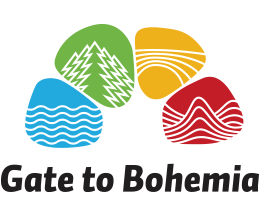Our starting point can be the village of Malé Žernoseky, located on the bank of the Elbe River. From the centre of the village we will follow the green sign to the romantic Oparenské Valley. The Lovoš educational trail goes through this valley, which will teach us about the local nature and history. Our road winds almost on a straight plane and around the burbling Milešovský Brook. You and your children may see many fish in its crystal clear water, such as the brook trout and if you are lucky, you may spot a salamander on its banks. You may also see wagtails and wrens playing on the river stones. You may ride your bike through the entire section, all the way to the Black Mill. To get there you have to make a slight climb but on your way back, you will just ride freely down. In the early days, you could hear several mills clattering in the valley, e.g. the Imperial, Mádr, Black, Swiss, New, Horák or Kačírek mill. Up to this day only four of them have survived but they look different and are used for different purposes. The Black Mill (formerly the Schwarzthaler Mühle) consists of three buildings waiting for reconstruction, but still providing food and shelter from the rain. The Swiss Mill (Schweizemühle), later the Havelka Mill, is completely unrecognisable today. Instead of the mill, we will find the Jordan camp site and children's camp here. Also here you will find a kiosk with refreshments and a place to relax. The Imperial Mill is now a private recreational building. The perished Mádr Mill is thought to be one of the oldest. It is said that in 1929, the mill had a 50-metre deep cellar, dating back all the way to pagan times. Apparently, the cellar was also used during World War I, as a food warehouse. The Mádr Mill used to bake excellent bread sought by people from the surrounding areas and was still operating during World War II. The first section of the valley is the most beautiful. Massive ash trees and hornbeam trees create a green canopy above the road, and we may only guess at the hidden railroad in the slope, while the creek covered by overgrown greenery gurgles peacefully. It is impossible to miss this beautiful place near the brook. Here, on an elevated spot, we will find a Plague Stone with a board depicting a double cross. The board was brought here from its original location in the plague cemetery and it is a monument commemorating the victims of the 1680 plague epidemic. Then we come to a well-maintained building called the Imperial Mill. Not far behind the mill you may hear the happy voices of children from the Jordan camp. The trip around the Milešovický Stream or beyond is not boring at all - you will walk around bridges, dams and through the hillside above the road where the railway track runs. Here, you may see several viaducts used as passageways. You can only admire the delicate sense and skills of the people who built this track, without disturbing the romantic character of the valley. At the end of our trip you will see the Black Mill with a pub inside. Here we may take a left turn towards the "Oparno railway station". We will pass under the viaduct, and behind it we shall see an educational trail crossroad sign, which will send us towards the ruins of Oparenský Castle 0.5 km away. It is thought that this small castle was founded in the late 13th century or at the beginning of the 14th century on a rocky cliff above the village of Oparno. It was built at the place of an older fortification called Hrádek (Little Castle) near the trade route connecting Prague with Saxony. The castle was already deteriorating during the reign of Jiří (George) of Poděbrady, and after 1520 the castle was completely abandoned. Since then, the castle has been left to its fate, and today we refer to this castle only as the "ruins". But even today you will find remnants of the perimeter walls on the cliff, vaulted cellar, the northern entrance of the palace and defensive trenches. The ruins are accessible by the general public and offer beautiful views of Milešovka and peaks of the Czech Central Mountains. This site is perfect for meditation and contemplation about the course of our times. We may take the same path to go back, or we may extend our trip by an additional 1.5 km and continue to follow the blue sign towards the Oparno Valley. The blue sign goes down towards the ruins of another mill. From here the green sign will take us back to the Black Mill. To go back we may take the same road, which will take us back to our starting point. Total length 6.5 or 8 km.
































